New Mars Forums
You are not logged in.
- Topics: Active | Unanswered
Announcement
#676 2015-09-09 05:08:33
- RobertDyck
- Moderator
- From: Winnipeg, Canada
- Registered: 2002-08-20
- Posts: 8,292
- Website
Re: Yet another Mars architecture
RobertDyck wrote:I saw an interview with SpaceX president Gwynne Shotwell who said she was considering building a new Falcon 9 using the stretched core from the strap-ons of Falcon Heavy. What lift capacity would that have? And I'm thinking to ISS orbit, so again we can use ISS as construction shack for orbital assembly of a Mars ship.
Do you have a link for that? I thought the boosters had the same size as the F9 core.
Bob Clark
Wikipedia: Falcon Heavy
Design revisions announced in 2015
SpaceX announced a number of changes to the Falcon Heavy rocket in 2015, and intends parallel design changes to the existing Falcon 9 v1.1 launch vehicle as well. The "new Falcon 9" has not yet been named, as of March 2015.
The new Falcon Heavy design will utilize as the two side cores the same core as the "new Falcon 9", while the center core of the Falcon Heavy will be a core with the original Falcon 9 v1.1 dimensions and structure. Design changes to the Falcon Heavy side cores will include a new propellant mix, changes to the launch vehicle thrust structure, a higher-performance engine—the Merlin 1D has completed a substantive round of additional qualification testing since it was initially used in late-2013 on the initial Falcon 9 v1.1 missions—and several size and volume changes to the first stage and second stage propellant tanks.
Changes will also be made to the second stage, but as of mid-March 2015, public sources on second stage detailed changes have only been only explicit about changes to the Falcon 9 second stage.
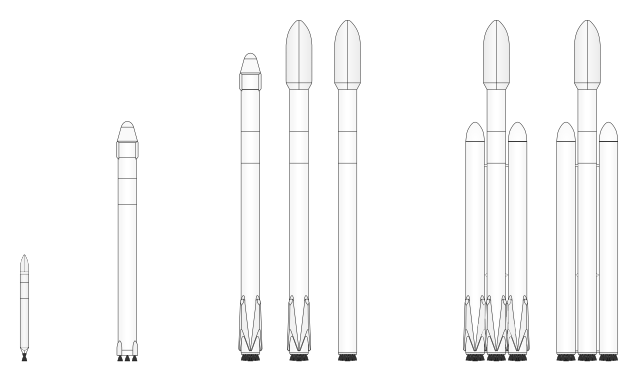
Notice the interstage that covers the second stage engine. It's the same location as Falcon 9 v1.1. But strap-on boosters extend higher than the core. This is also seen on the SpaceX web page for Falcon Heavy, in the cut-away view that shows the upper stage engine.
The Wikipedia article has a reference for the "new Falcon 9". That links to an article on SpaceNews:
SpaceX Aims To Debut New Version of Falcon 9 this Summer
SpaceX plans to inaugurate its new, more-powerful Falcon 9 rocket this summer, using the same Merlin 1D engine with a modified fuel mix and other changes to extend the company’s planned reuse of the first stage to cover all SpaceX launches, SpaceX President Gwynne Shotwell said.
In March 16 and 17 appearances at the Satellite 2015 conference here, Shotwell said the new-version Falcon 9, which has yet to be named, will be about 30 percent more powerful than the rocket’s current version.
...
The Falcon 9 v1.1 rocket needs more power to perform the same maneuver after a launch carrying a telecommunications satellite to geostationary orbit 36,000 kilometers over the equator, thus the need for the upgraded engine.
...
“Falcon Heavy is two different cores — the inner core and the two side sticks,” Shotwell said. “The new Falcon 9 will basically be a Falcon Heavy side booster. So we’re building [only two different] cores to make sure we don’t have a bunch of configurations around the factory so we can streamline operations and hit a launch cadence of one or two a month from every launch site we have.”The upgraded Falcon 9, Shotwell said, will make its inaugural flight this summer. Customer SES of Luxembourg has said it is willing to be the first customer for the launch of a 5,300-kilogram telecommunications satellite to geostationary orbit.
I guess that partially answers my question. So the upgraded Falcon 9 can lift 5,300kg to geostationary orbit, although that interview is not clear if it's GEO (circularized) or GTO. What could it lift to ISS?
Last edited by RobertDyck (2015-09-16 18:03:55)
Offline
Like button can go here
#677 2015-09-09 18:10:50
- SpaceNut
- Administrator
- From: New Hampshire
- Registered: 2004-07-22
- Posts: 29,889
Re: Yet another Mars architecture
Data for geostationary orbit.... http://finance.yahoo.com/news/spacex-fa … 20088.html
The 224-foot (68-meter) tall rocket burst off its seaside launch pad at 5:06 p.m. EST (2206 GMT), soaring through overcast skies as it headed toward the satellite's drop-off point more than 55,000 miles (88,500 km) above Earth or about one-quarter of the way to the moon.
From that position, the 6,649-pound (3,016 kg) Thaicom 6 satellite is designed to lower itself to about 22,300 miles (35,888 km) above Earth and shift the angle of its orbit so that it can be permanently stationed to beam high-definition and digital television services to customers in Thailand and surrounding areas.
Offline
Like button can go here
#678 2015-09-10 10:04:39
- Tom Kalbfus
- Banned
- Registered: 2006-08-16
- Posts: 4,401
Re: Yet another Mars architecture
Just to draw your attention, here is a good landing site:
http://newmars.com/forums/viewtopic.php?id=7288
Offline
Like button can go here
#679 2015-09-16 17:21:26
Re: Yet another Mars architecture
GW, on another forum was mentioned a louder than usual Falcon 9 test firing. Did you hear it?
Bob Clark
Old Space rule of acquisition (with a nod to Star Trek - the Next Generation):
“Anything worth doing is worth doing for a billion dollars.”
Offline
Like button can go here
#680 2015-09-16 18:22:29
- RobertDyck
- Moderator
- From: Winnipeg, Canada
- Registered: 2002-08-20
- Posts: 8,292
- Website
Re: Yet another Mars architecture
Innnnnteresting. Very innnnnteresting. SpaceX has updated their website. They now show Falcon 9 with the same core stage as a side stick from Falcon Heavy. And the core of Falcon Heavy has changed to be the same as a side stick. They increased second stage burn time from 375 seconds to 397 seconds. Falcon 9 first stage burn time reduced from 180 seconds to 162 seconds, although thrust at sea level increased from 5,885kN to 6,806kN, and thrust in vacuum from 6,672kN to 7,426kN. Overall height changed from 68.4m to 70m. Mass increased from 505,846kg to 541,300kg. The strange thing is they claim payload to LEO is exactly the same: 13,150kg. Both old and new versions showed landing legs, but the new one had grid fins. And the old image showed Dragon CRS while the new one shows Dragon v2, but spec's for Falcon 9 are independent of Dragon.
Could someone explain this to me. Why would increasing the size of both stages result in the same payload to LEO? Are they leaving greater propellant reserve to return the first stage for landing?
Offline
Like button can go here
#681 2015-09-16 20:43:46
- SpaceNut
- Administrator
- From: New Hampshire
- Registered: 2004-07-22
- Posts: 29,889
Re: Yet another Mars architecture
Ya it should be simular to the delta iv family lift as seen by the delta iv to its heavy version
https://en.wikipedia.org/wiki/Delta_IV to https://en.wikipedia.org/wiki/Delta_IV_Heavy

Offline
Like button can go here
#682 2015-09-16 20:56:31
Re: Yet another Mars architecture
Several times I have seen references to increasing the size of the Falcon 9 so they can keep the same payload to LEO and reuse the first stage. That also means without reuse they can put more into LEO and more to GTO. They have already lofted satellites 10% heavier to GTO than Falcon 9 supposedly can do because they did not try to land the first stage.
What I wonder is whether the Falcon Heavy will have a larger payload. The new Falcon 9 has more thrust and mass than the old one that was to be used with the Falcon Heavy. If they get 10% more to LEO, the 53 tonnes grows to 58 tonnes. And the way they keep tweaking their rocket, it may very well be that by the time the Space Launch System finally flies, the Heavy will be within spitting distance of the same payload! A 30% increase on 53 tonnes is 71 tonnes.
Offline
Like button can go here
#683 2015-09-17 07:26:30
Re: Yet another Mars architecture
Innnnnteresting. Very innnnnteresting. SpaceX has updated their website. They now show Falcon 9 with the same core stage as a side stick from Falcon Heavy. And the core of Falcon Heavy has changed to be the same as a side stick. They increased second stage burn time from 375 seconds to 397 seconds. Falcon 9 first stage burn time reduced from 180 seconds to 162 seconds, although thrust at sea level increased from 5,885kN to 6,806kN, and thrust in vacuum from 6,672kN to 7,426kN. Overall height changed from 68.4m to 70m. Mass increased from 505,846kg to 541,300kg. The strange thing is they claim payload to LEO is exactly the same: 13,150kg. Both old and new versions showed landing legs, but the new one had grid fins. And the old image showed Dragon CRS while the new one shows Dragon v2, but spec's for Falcon 9 are independent of Dragon.
Could someone explain this to me. Why would increasing the size of both stages result in the same payload to LEO? Are they leaving greater propellant reserve to return the first stage for landing?
Yes. That is indeed odd. The entire purpose of the upgrade was to increase the payload to GTO while maintaining reusability, in fact by 33%. But this should also increase the payload to LEO as well.
Bob Clark
Old Space rule of acquisition (with a nod to Star Trek - the Next Generation):
“Anything worth doing is worth doing for a billion dollars.”
Offline
Like button can go here
#684 2015-09-17 08:46:38
- RobertDyck
- Moderator
- From: Winnipeg, Canada
- Registered: 2002-08-20
- Posts: 8,292
- Website
Re: Yet another Mars architecture
Yes. That is indeed odd. The entire purpose of the upgrade was to increase the payload to GTO while maintaining reusability, in fact by 33%. But this should also increase the payload to LEO as well.
Bob Clark
Published payload to GTO also remained the same: 4,850kg
Falcon Heavy had many of the same statistics. First stage changed from thrust at sea level 17,615kN, in vacuum 20,017kN, to thrust at sea level 20,418kN, in vacuum 22,279kN. Mass from 1,462,836kg to 1,394,000kg. Interesting that total mass went down. Total width increased from 11.6m to 12.2m. They have more space between cores; probably due to grid fins. Payload to LEO remained the same: 53,000kg. Payload to GTO also remained the same: 21,200kg.
Offline
Like button can go here
#685 2015-09-17 09:16:29
- GW Johnson
- Member
- From: McGregor, Texas USA
- Registered: 2011-12-04
- Posts: 6,101
- Website
Re: Yet another Mars architecture
First stage reuse is by retropropulsion flyback. That propellant has to come from somewhere, so if you do not change stage performance, then payload delivered must reduce for there to be recovery.
I think their original approach was reduced payload masses on recovered flights. That appears to have changed.
Apparently, they are now keeping the same payloads as older versions, and "upping" first stage performance and size to support flyback recovery. Do not expect the numbers to stabilize until they get recovery working right. At this stage of the game, no one yet knows exactly what recovery will require in the way of propellant.
The confusion over core sizes is also partly driven by the need to limit the number of configurations to keep track of in their production facility. Eventually, I predict there will be one common core for both -9 and -H, and the -H side boosters should eventually be the same core. But those configurations won't "stabilize" until they learn fully how to do their recovery.
I haven't noticed any unusually-loud firings myself, although I did see a local TV notice that a louder-than-usual one might take place today. There are usually at least 2 tests per day now, of things big enough for me to hear inside my house, some 6 miles away.
GW
GW Johnson
McGregor, Texas
"There is nothing as expensive as a dead crew, especially one dead from a bad management decision"
Offline
Like button can go here
#686 2015-09-17 20:00:28
- SpaceNut
- Administrator
- From: New Hampshire
- Registered: 2004-07-22
- Posts: 29,889
Re: Yet another Mars architecture
Last I knew, the side boosters were reusueable but the central core would not be. That the single rocket that is recoVerable is still x2 that Value and the full mass of the single to orbit at a minimum....I would be nice to get to the common core design sooner not later with the reuseability of a landing successful.....
Offline
Like button can go here
#687 2015-09-18 09:57:52
- GW Johnson
- Member
- From: McGregor, Texas USA
- Registered: 2011-12-04
- Posts: 6,101
- Website
Re: Yet another Mars architecture
Spacex's own (shifting) illustrations on the website showed landing legs and grid fins on all 3 first stage items for Falcon-H, last time I was there a few days ago.
Give them time to "fix" Falcon-9, and more importantly, learn how to recover stages. Maybe the engines can really be reused. I doubt the tankage ever will be. Once these issues become "known, the confusion over configurations and payloads will disappear.
Once Falcon-H is flying routinely, then we'll see some real engineering effort toward their big methane-LOX engine and the MCT giant rocket that will use them. Spacex is busy trying to cope with what they have underway right now.
Even so, I tentatively bet MCT might reach a testing stage before the 100-ton version of SLS ever flies. And its unit price to LEO will be factor 4 cheaper than SLS.
GW
Last edited by GW Johnson (2015-09-18 10:00:02)
GW Johnson
McGregor, Texas
"There is nothing as expensive as a dead crew, especially one dead from a bad management decision"
Offline
Like button can go here
#688 2015-09-23 23:50:51
- RobertDyck
- Moderator
- From: Winnipeg, Canada
- Registered: 2002-08-20
- Posts: 8,292
- Website
Re: Yet another Mars architecture
I'm going to ask you guys to help flesh this out. We should seriously develop an alternate mission architecture for Mars. I'm going to update my plan again.
First mission:
- 1 SLS Block 2B for MAV (direct launch from KSC to Mars surface)
- 1 SLS Block 2B for lab & pressurized rover (direct launch)
- 1 Falcon 9 v1.2 for ITV
- 1 Falcon Heavy for TMI stage
- 1 Falcon 9 lander & unpressurized rover
- 1 Falcon 9 for Dragon
Subsequent missions:
- 1 SLS Block 2B for MAV
- 1 Falcon Heavy for TMI stage
- 1 Falcon 9 lander & unpressurized rover
- 1 Falcon 9 for Dragon
I'll repeat a few key features. ITV is reusable, assembled at ISS, fly to high Mars orbit and back to ISS. Designed for 12 missions. Propulsion stages are expended. TMI stage is LOX/LH2, used as counterweight for artificial gravity, discarded on approach to Mars. MAV docks to ITV, is the TEI stage, counterweight during transit back to Earth, discarded on approach to Earth. ITV will have only one story, with life support on that same story. A Dragon capsule docked to underside of ITV, with ADAPT heat shield for aerocapture beneath that. Mars lander docks to top of ITV. MAV docks to that same top port, but releases after TEI with cable for artificial G.
Question: This would mean "down" is the floor during TMI from Earth, but ITV will be upside-down during thrust from Mars orbit. Remember the Apollo LM was upside-down during thrust for LOI. Should the MAV transfer to the heat shield side for thrust? This could be done with remote operation. The ITV will require attachment points for the TMI stage, the MAV could attach to those.
I changed the launch vehicle for the ITV to Falcon 9 v1.2, the version with the same core as a side stick of Falcon Heavy. And launch without legs or ability to recover the first stage. That will maximize payload to LEO. Falcon 9 is only rated for 5 metre diameter fairing. Should the ITV be a Bigelow inflatable? Can an inflatable survive 26 years in space?
The lander will be attached to the ITV during crew transit. The ITV will have food for both transit to Mars, and back to Earth. The lander will be the surface hab so will have food for the entire surface stay. This way if a free return is necessary, it has lots of food. And the surface hab will have life support, so a fully redundant set of life support should something dire happen.
The surface hab will not require a micrometeoroid shield. However, the storage bag for transit from Earth will. The outermost layer of fabric for an EMU spacesuit is Orthofabric, the outermost layer of TransHab or Bigelow hab or blankets on ISS modules use the same thing. This is designed for conditions in space, either LEO or Moon, but not the surface of Mars. I argue for Tenara architectural fabric. The surface hab will require thermal insulation that works in the atmosphere of Mars; I suggest Thinsulate. Can an inflatable surface hab support sand bags on its roof?
Do you want to help me calculate the mass of module? Keep the TMI stage within lift capacity to ISS for the launch vehicle.
Last edited by RobertDyck (2015-09-24 18:31:10)
Offline
Like button can go here
#689 2015-09-24 17:08:06
Re: Yet another Mars architecture
Dear Robert:
I think I am getting sufficiently familiar with your plan to be able to offer some suggestions.
1. I doubt there's a problem pushing the ITV from its ceiling. I suppose the astronauts would ride in the MAV because the seats there are oriented the right way for the acceleration.
2. I don't know whether anyone knows whether inflatables will be good for 26 years. I wonder whether there's a way to contact the Bigelow people? They might be able to tell you. But consider that most of the mass of the inflatable is not the shell; it's the life support equipment, computers, RCS, communications, furniture, etc. Those things are going to be replaced and refurbished several times in 26 years, anyway. The shuttles were updated fairly often because technology improved. One could always launch an empty inflatable into orbit, inflate it, and transfer over the equipment from an old inflatable that is still good, if the shell is getting old.
Personally, I think inflatables will prove to be the way to go. They appear to be better in case of meteoroid impact and because they have very little metal, they provide better radiation shielding. The other advantage is that smaller fairings will accommodate them. I find it hard to believe that the SLS will fly very much in the 2020s, IF the Falcon Heavy starts to fly regularly and the first stages prove to be reusable. Even now, the Heavy is supposed to put 53 tonnes into LEO for less than 100 million. If that price drops to $25 million because of reusability, who wants to put 130 tonnes into orbit on an augmented SLS for about a billion? NASA will be a laughing stock and the pork barrel efforts to preserve the SLS will look ludicrous. I think (politics can be very unreal).
What masses were you using?
Offline
Like button can go here
#690 2015-09-25 00:16:55
- RobertDyck
- Moderator
- From: Winnipeg, Canada
- Registered: 2002-08-20
- Posts: 8,292
- Website
Re: Yet another Mars architecture
Perhaps we should we should start over. I've carried forward estimates too long. In the discussion Light weight nuclear reactor, updating Mars Direct, I gave life support mass. It's equipment from the US side of ISS, specifications from Hamilton Sundstrand.
Waste Collector Subsystem (space toilet): 246 lbs
Water Processor Assembly: 1,450 lbs
Urine Processing Assembly: 383 lbs
SPE ® Oxygen Generation Assembly (OGA): 1,465 lbs
Sabatier reactor: ? (manufacturer)
CO2 Compressor for Sabatier: ? (manufacturer)
Regenerable CO2 Removal System: 105 lbs. (Metox Regenerator), 32 lbs. (Metox Canister in regenerated state)
Dehumidifier: Common Cabin Air Assembly (CCAA): 212.6 lbs
Mass of OGA from STS-121 press kit. Sabatier was delivered on STS-131, but all the press kit said was "life support equipment".
It's getting late, I'll finish this later.
Offline
Like button can go here
#691 2015-09-25 18:27:55
#692 2015-09-26 02:39:25
- RobertDyck
- Moderator
- From: Winnipeg, Canada
- Registered: 2002-08-20
- Posts: 8,292
- Website
Re: Yet another Mars architecture
Four people. Remember I started with Mars Direct, and modified it.
Offline
Like button can go here
#693 2015-09-26 06:56:38
Re: Yet another Mars architecture
...
I haven't noticed any unusually-loud firings myself, although I did see a local TV notice that a louder-than-usual one might take place today. There are usually at least 2 tests per day now, of things big enough for me to hear inside my house, some 6 miles away.
GW
According to this the test firing was on the 21st:
WATCH SPACEX TEST-FIRE ITS UPGRADED FALCON 9 ROCKET ENGINE
NOW MORE POWERFUL THAN EVER, AND GETTING READY FOR TAKEOFF IN NOVEMBER
By Sarah Fecht Posted Yesterday at 2:04pm
http://www.popsci.com/watch-spacex-rev- … ket-engine
Bob Clark
Old Space rule of acquisition (with a nod to Star Trek - the Next Generation):
“Anything worth doing is worth doing for a billion dollars.”
Offline
Like button can go here
#694 2015-09-26 20:11:51
- SpaceNut
- Administrator
- From: New Hampshire
- Registered: 2004-07-22
- Posts: 29,889
Re: Yet another Mars architecture
With regards to RobertDyck post #688 rocket launchers , manifest ect....
http://foia.msfc.nasa.gov/docs/SLS-PDR- … Report.pdf
The critical path for these operations is the manufacturing of the motor segments (82 weeks) and the customer inspection, loading, and shipping of the completed segments to KSC (8.6 weeks). The SLS Core stage manufacturing flow includes approximately 33 months and 6 months for green run testing.
http://democrats.science.house.gov/site … %20R.8.pdf
As the shuttle program neared its end, schedule estimates for call up of an external tank ranged from 36 to 44 months.
http://spacedevelopmentsteeringcommitte … -strategy/
The SLS is constrained to use Space Shuttle components and workforce to the maximum extent practical by the NASA Authorization Act of 2010.
http://www.commerce.senate.gov/public/? … a6a8824b01
For instance, the side mounted boosters are modified Space Shuttle solid fuel boosters except with 5 segments instead of 4 for extra performance. Similarly, the rocket engines for the core stage are modified Space Shuttle RS-25 main engines. The core stage utilizes much of the same tooling and the same workforce as the Space Shuttle External Tank. The contractors for these major components are the same contractors as for the Space Shuttle. Thus there has been very little competition in the development of the SLS. This fact, coupled with the cost-plus contracts that are subject to the Federal Acquisition Regulation has been contributing to the ballooning cost of the SLS.
http://www.spudislunarresources.com/blo … ar-return/
The latest agency Augustining is a report describing a two-launch, Space Launch System (SLS) sortie mission to the Moon. Because only one launch pad at the Cape (Launch Complex 39) is being modified to accommodate the SLS, launches must be scheduled every six months, resulting in a fully fueled lander waiting in space for 6 months before the arrival of a human crew.
Offline
Like button can go here
#695 2015-09-26 21:40:38
- RobertDyck
- Moderator
- From: Winnipeg, Canada
- Registered: 2002-08-20
- Posts: 8,292
- Website
Re: Yet another Mars architecture
SpaceNut: Are you arguing to abandon SLS? Those manufacturing times are excessive in the extreme. Shuttle was able to launch 6 times per year; orbiter processing was the limitation. ATK build manufacturing facilities with casting pits sized for 100 boosters per year, or 50 launches per year. That's what they hoped when Shuttle was designed. And that overcapacity of all support facilities was one reason Shuttle cost so much. Considering ATK will continue to manufacture SRBs, and Michoud will continue to manufacture core stage tanks, I have difficulty believing they will launch only once every 6 months. And remember, the Vertical Assembly Building has 4 high bays, two on each side. There are 2 crawlers and 3 Mobile Launchers. Saturn V Mobile Launchers were converted into Mobile Launch Platforms for Shuttle, but the pad has the static service structure removed so MLPs will have the service structure re-attached. The building would support assembly of 4 launch vehicles, but only 3 MLs mean only 3 vehicles. Here is a Shuttle era floor plan of the VAB.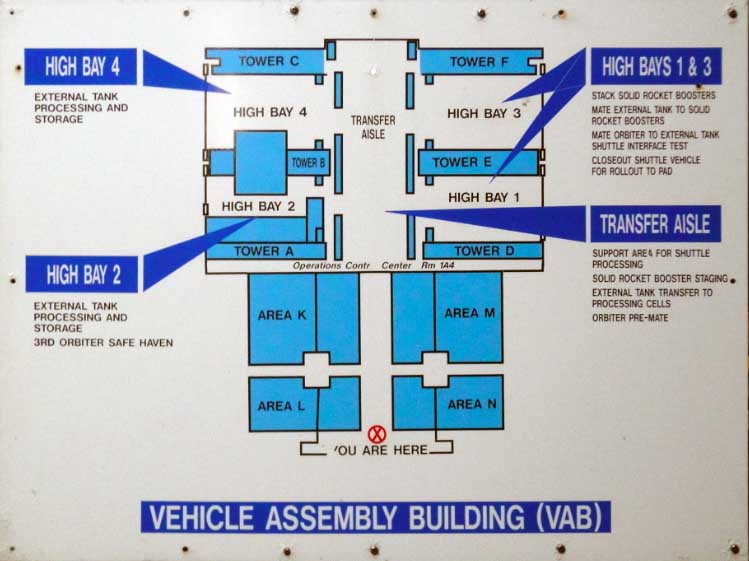
And an Apollo era cut-away drawing: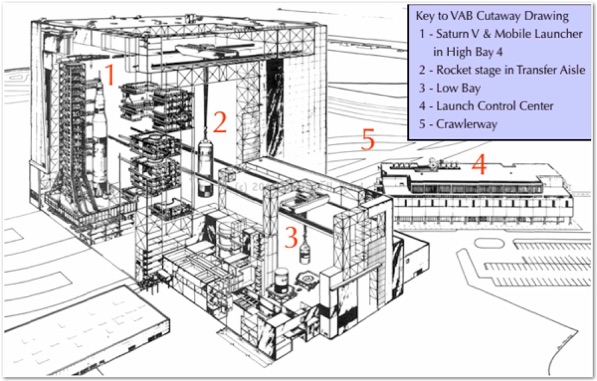
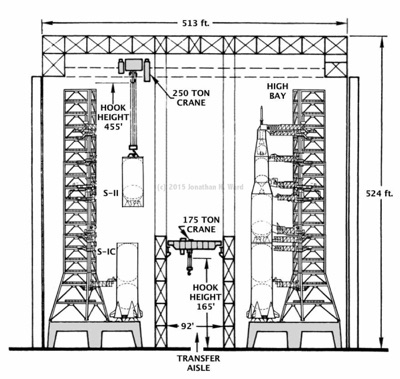
Offline
Like button can go here
#696 2015-09-26 22:00:09
- SpaceNut
- Administrator
- From: New Hampshire
- Registered: 2004-07-22
- Posts: 29,889
Re: Yet another Mars architecture
Actually no just been searching for why the slow turn out rate for Nasa missions using the SLS which is why I question whats out there on the web since you have given the manufacturing capacity of what can be done if Nasa does get it all going....
Offline
Like button can go here
#697 2015-09-26 22:54:02
- RobertDyck
- Moderator
- From: Winnipeg, Canada
- Registered: 2002-08-20
- Posts: 8,292
- Website
Re: Yet another Mars architecture
Mars Direct habitat figures, from the June 25-29 1990 symposium.
Gross Mass (All Units in tonnes)
Main Structure (Weldalite)
Barrel Section Wall 1.97
Decks (3) 2.53
Central Airlock/Rad Shelter 1.54
4 Perimeter Airlock Doors 0.40
Interior Fittings
Walls 0.08
Furniture 0.45
Science Equipment 0.30
Exercise & Health 0.20
Plumbing & Lighting 0.10
Replacement Air (3 charges) 0.81
Solar Panel on Roof 0.25
Life Support System 2.00
Consumables for Crew (Whole Food) 8.76
Crew 0.30 (that works out to average body weight 75kg = 165lb)
Personal Effects 0.30
Space Suits 0.30
Pressurized Rover 1.60
Deployed Surface Science 0.20
Contingency 3.90
The chart in "The Case for Mars" 1997 edition changed that:
Hab structure 5.0
Life-support system 3.0
Consumables 7.0
Electric power (5 kWe solar) 1.0
Reaction control system 0.5
Communications and information management 0.2
Lab equipment 0.5
Crew 0.4 (average body weight 100kg = 220lb)
EVA suits (4) 0.4
Furniture and interior 1.0
Open rovers (2) 0.8
Pressurized rover 1.4
Field science equipment 0.5
Spares and margin (16 percent) 3.5
Adapting for ITV, assume hard wall aluminum-lithium alloy (Weldalite):
Barrel Section Wall 1.97
Decks (2) 1.69
Central Airlock/Rad Shelter 1.54
Airlock Doors (side, top, bottom) 0.30
Interior Fittings
Walls 0.08
Furniture 0.45
Exercise & Health 0.20
Plumbing & Lighting 0.10
Replacement Air (2 charges) 0.54
Solar Panel 0.10
Battery with power for 12 hours life support (equivalent to 5 Tesla Powerwalls) 0.50
Life Support System 2.00
Consumables for Crew (Food) 2.99
Reaction Control System 1.375
---
Total 13.835 tonnes
The ITV is designed for 180 days transit to Mars, 180 days return. In case of Free Return, the surface hab will be attached along with all its food. So the ITV carries 360 days food for 4 crew, dehydrated like Shuttle food. Plus contingency, but to cover recycling losses this is whole food like ISS. To make the flight enjoyable, one day whole food per week.
Space Shuttle Food
Weight allowed for food is limited to 3.8 pounds per person per day, which includes the 1 pound of packaging for each person each day.
an astronaut on the ISS uses about 1.83 pounds (0.83 kilograms) of food per meal each day.
dehydrated (Shuttle): 4 crew * 3.8 pounds * 360 days = 5472 pounds = 2.482 tonnes
whole food (ISS): 4 crew * 0.83kg * 3 meals per day * 51 days = 0.50796 tonnes
Total food: 2.99 tonnes
Life Support for ISS added up to 1.7 tonnes. Add Sabatier and CO2 compressor. And I want to add a direct CO2 electrolysis system, based on the "Mars In-situ Propellant production experiment (MIP)" of the Mars Surveyor 2001 Lander. Launch of that spacecraft was cancelled after Mars Polar Lander failed. The spacecraft was reconfigured to become Mars Phoenix. The Sabatier reactor is limited by hydrogen from water electrolysis, so it can only use half of the CO2 scrubbed from cabin air. The purpose of CO2 electrolysis is to recover some O2 from the half of CO2 that is currently dumped in space. This system will recover only 40% of O2 in that CO2, but that's better than 0%. This will augment the system from ISS, improving recycling efficiency. The ITV includes a washroom with sink and shower; the Water Processing Assembly can already recycle wash water.
Reaction Control System is thrusters including engines, tanks, and propellant. It's needed to rendezvous with ISS, whether for initial delivery or return from Mars. Dragon CRS caries 1,290kg of propellant using MMH/N2O4. It has 18 Draco thrusters in 4 engine pods, 2 with 4 thrusters, 2 with 5. Apollo SM had 4 thruster quads, each with 4 engines, total 16 engines. Draco thrusters provide 400 Newton (90 pounds force) thrust, but engine mass is hard to find. Apollo RCS thrusters each provided 100 pounds thrust, engine mass 5.17 lb (2.33kg). An Apollo RCS propellant tank massed 7 lbs (3kg). Each thruster quad had 2 tanks of propellant, 2 of oxidizer, and one helium tank as pressurant. Modern systems use composite tanks. Interesting that Encyclopedia Astronautica says Apollo SM used UDMH for propellant, but other references say Aerozine-50 for the main engine, MMH for thruster quads. But just so I can put something here, assume the same thruster quads as Apollo SM. Thrusters and dry propellant tanks (not including helium tanks) mass 85.28kg. So add 1,290kg for Dragon CRS propellant. Total 1375.28kg for RCS.
Last edited by RobertDyck (2015-09-27 09:37:54)
Offline
Like button can go here
#698 2015-09-27 01:16:04
- RobertDyck
- Moderator
- From: Winnipeg, Canada
- Registered: 2002-08-20
- Posts: 8,292
- Website
Re: Yet another Mars architecture
Power for life support for 4 crew members works out to 1.2929 watts, not including the compressor for the Sabatier, and not including CO2 electrolysis. That doesn't include active thermal control system (air conditioner). It also doesn't include lights, communication, or electronics. Dragon has solar panels that provide 4 kW max. Size for that, end of life at Mars.
Spectrolab is owned by Boeing Satellite Systems. They manufacture 3 solar cells for space:
Improved Triple Junction (ITJ): Beginning Of Life (BOL) 26.8% @ maximum power, 26.5% @ load voltage. End Of Life (EOL) 22.5% @ max power, 22.3% @ load.
Ultra Triple Junction (UTJ): BOL 28% @ max power. Not specified for @ load voltage, or EOL.
neXt Triple Junction (XTJ): BOL 29.5% @ max power, 29.3% @ load. Not specified for EOL.
Calculate for 4 kW and ITJ EOL @ load. And Mars has 47% sunlight. ITJ panels for area > 2.5 m² produce 330 W/m² BOL. Multiply by 22.3/26.8 for EOL @ load. Mutilply by 47% for Mars orbit. That works out to 129 W/m². To produce 4kW that will require 31 m². Mass with 3 mil Ceria Doped Coverslide is 1.76 kg/m², mass with 6 mill Ceria Doped Coverslide is 2.06 kg/m². If we use the thicker coverslide, that works out to 63.86 kg. Add to that hinges, springs, and latches to unfold. And support rod, mount bearing, and motor to track the Sun. And mechanism to retract/fold, and protective cover for aerocapture.
Robert Zubrin estimated 250 kg (0.25 tonne) for solar panels. In "The Case for Mars" he estimated 1.0 tonne for 5 kW, total mass for electric power. Assume that includes the battery. Not bad. So without battery I dropped it to 100kg.
Last edited by RobertDyck (2015-09-27 07:53:25)
Offline
Like button can go here
#699 2015-09-27 10:02:34
- RobertDyck
- Moderator
- From: Winnipeg, Canada
- Registered: 2002-08-20
- Posts: 8,292
- Website
Re: Yet another Mars architecture
I added Reaction Control System to the ITV, and delete crew, suits, and personal effects. Those will be carried on the spacecraft that delivers crew. Falcon 9 v1.1 is capable of carrying Dragon CRS to ISS. It masses 4.200 tonnes dry weight, 1.290 tonnes propellant, plus 6.000 tonnes cargo; total 11.490 tonnes launch weight not including nose cap or solar array fairings. If the ITV is inflatable, then it would fit in a standard Falcon 9 fairing: 5.2 metre outside diameter, 4.6 metre inside payload diameter.
Offline
Like button can go here
#700 2015-09-27 15:18:04
- SpaceNut
- Administrator
- From: New Hampshire
- Registered: 2004-07-22
- Posts: 29,889
Re: Yet another Mars architecture
The ITV as well as the surface habitat needs more than just the power to run the life support only figures as its not the complete number for a crew to survive with.
Somewhere I saw that Nasa was using 10 kW hrs for crew size of 4 for life support and Orion useage but that may have been the size of the panels that they planned to use and not the actual useage of crew.
Just like your car, Orion will need electrical power to run all of its electronics such as lights, air conditioning, and radios. Unlike your car, Orion’s electrical power will be vital to supporting the life of its crew. The power system for the service module must generate and store electrical power from the launch pad until the crew module separates just prior to reentry. Solar power will be used while in low Earth orbit, lunar orbit, and during the flights between Earth and the Moon. Two photovoltaic solar arrays located at the rear of the service module will be used to convert sunlight into electricity. The solar array system includes two array panels, deployment mechanisms, Sun sensors, and gimbals (powered joints) to maintain optimum line-of-site with the Sun. Each array is approximately 5 meters (16 feet) in diameter and provides 9 kilowatts of power. This size requires the arrays to be folded during launch and deployed only after Orion reaches a stable orbit above the Earth.From the launch pad until orbit, Orion will use lithium-ion batteries that store electrical power. They will also be needed when the spacecraft is in the shadow of the Earth or the Moon. When in sunlight, the arrays will charge three lithium-ion batteries in the service module and six in the crew module.
https://en.wikipedia.org/wiki/Orion_service_module
The voltage, 28 volts DC, is similar to that used on the Apollo spacecraft during flight.
The new design for the solar arrays, replacing ATK's circular UltraFlex design, is by Airbus Defence and Space, whose subsidiary, Dutch Space, built the ATV's X-shaped array of four panels.
The ATV's array generated 4.6 kilowatts.
The upgraded version for the service module will generate about 11 kilowatts, and will span about 62 feet (19 m) when extended.
Solar Power for Outer Planets Study used on Dawn, Juno and Rosetta using Triple Junction cells...
NASA develops origami style solar panels to be used in space
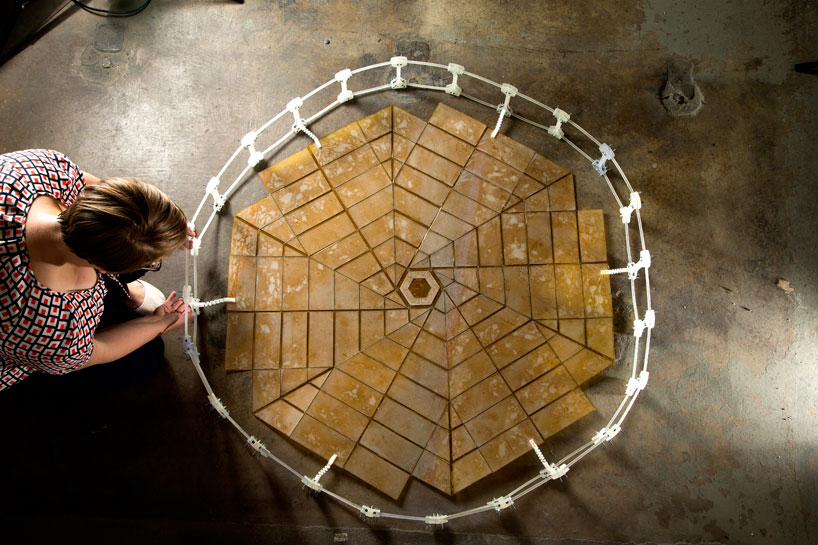
The array folds up to be 8.9 feet (2.7 meters) in diameter and 82 feet (25 meters) across when unfolded, their 1/20th scale prototype expands to a deployed diameter of 4.1 feet (1.25 meters).
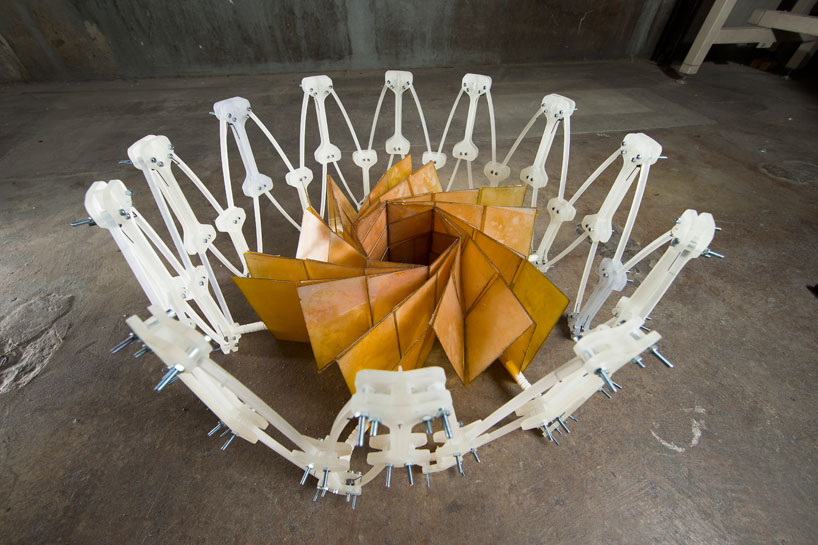
While the ITV will see a steady source of solar but the planets surface is another thing when it comes to storage and sizing of an array for a crew to survive with. Its hard to come up with more of either if its not already there just awaiting for the crew to plug it in for when its needed.
Offline
Like button can go here